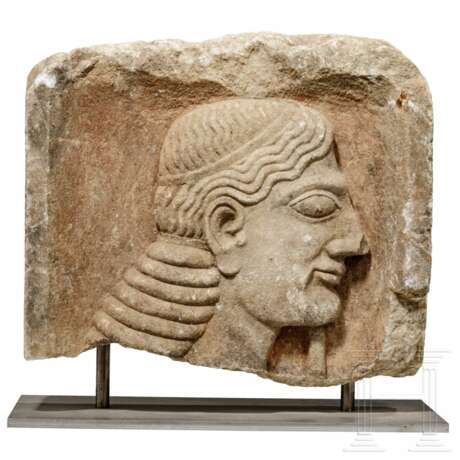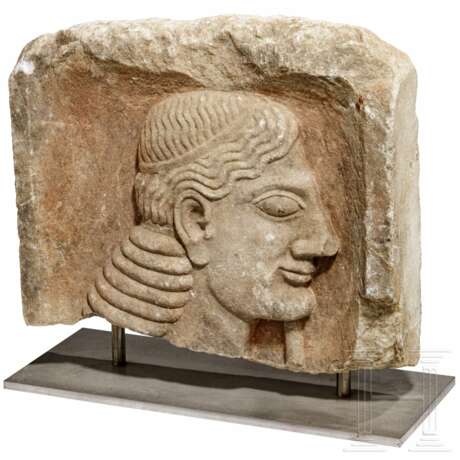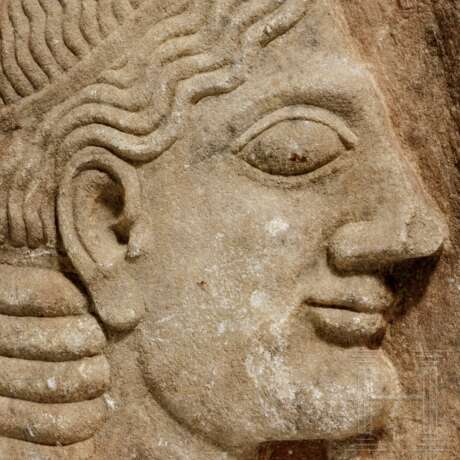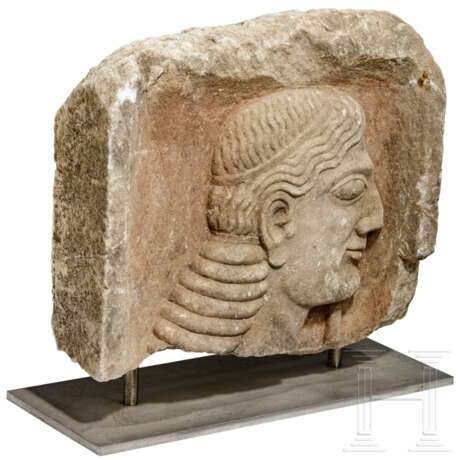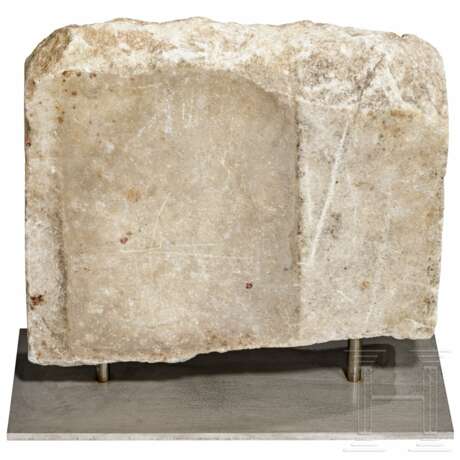Archaische Grabstele eines Kriegers, Griechenland, 1. Hälfte - Mitte 6. Jhdt. v. Chr.
22.11.2021 10:00UTC +01:00
Classic
Starting price
100000EUR € 100 000
| Auctioneer | Hermann Historica |
|---|---|
| Event location | Germany, Grasbrunn / München |
| Buyer Premium | 25 % |
Archive
The auction is completed. No bids can be placed anymore.

ID 658920
Lot 771 | Archaische Grabstele eines Kriegers, Griechenland, 1. Hälfte - Mitte 6. Jhdt. v. Chr.
Estimate value
€ 100 000
The heavy bronze figure with thick walls, produced by applying the lost-wax casting technique, probably with a clay core inside. The style and method clearly suggest it dates from classical antiquity. Two features of the remarkable bronze sculpture stand out in particular: firstly, the unusual size for a bronze sculpture of a bird from classical antiquity, such as is very rarely found; secondly, the surface is characterised by the exceptionally fine, naturalistic rendering of the plumage. The bird standing in repose, its wings tightly folded and head upright, slightly turned to the left. The tail feathers pointed slightly downwards, protruding from beneath the wings. The tops of the metatarsal bone (tarsometatarsus), covered in scales, still in place below the feathered tarsi. The toes and talons have been lost. The musculature of the bird is clearly delineated. The feathers on the surface of the body are exceptionally finely and precisely chased, representing the shafts of the quill and the vanes extending on either side, whereby previously finished structures on the lost wax model have been further refined. The eyes with clearly contoured lids, the pupils with a pronounced, overhanging bulge. The hooked beak clearly identifying it as a bird of prey. The upper and lower beak precisely executed, along with the openings at the root. While the right-hand side, presumably the original outer side, shows a stern gaze, the left side, turned slightly inwards, reveals a gentler appearance. The eagle was probably part of a group of figures and it may be assumed that a second bird or a life-sized (or almost life-sized) figure was placed on the postulated inner side. Although the bulge over the eyes is not in a straight line and does not represent the typical "eagle gaze", it may be assumed that the statue is meant to be an eagle.
It is not easy to give a precise date for this object as it may be considered unique as regards to its size and the quality of the craftsmanship. A Greek bronze votive offering from the Acropolis Museum (dated to the late 6th century B.C.) shows a bird standing somewhat more erect, without the slight inclination of the head, but exhibiting very similar musculature and posture. Magna Graecian tetradrachms from Akragas (1st quarter of the 5th century B.C.) at the turn of the Archaic to the early classical period feature birds that are unmistakably eagles, the silhouettes of which, combined with the fine markings of the plumage and the specifically rounded head, often appear to be miniatures of the eagle presented here. Generally speaking, in Roman art, eagles are depicted with a coarser plumage in higher relief, their posture is usually more dynamic and the facial expression more aggressive.
By contrast, concepts of art that were invariably supplied by local traditions are conceivable, particularly in the eastern half of the empire. The exceptionally realistic, yet rather undramatic and serene depiction of the eagle might also suggest that it was made during the late Hellenistic period (1st century B.C. – 1st century A.D.)
The surface is covered with an almost flawless, uniform, olive green patina, whose silk-matte lustre perfectly accentuates the finely delineated anatomical details. An antique hairline crack running across the right-hand side. Minor casting defects have been repaired after casting in typical antique fashion and the surfaces re-chased accordingly. A masterpiece of antique bronze casting with meticulously worked details, the unconventional stylisation in keeping with the specific artistic intention and of unusual stature for the subject. Height 32 cm (including pedestal 38.5 cm).
Provenance: From the collection of a South German classical philologist, acquired by him during the 1950s and 1960s. Remaining thereafter in the family estate.
Condition: II
Bronzener Adler von ungewöhnlicher Größe und ausgesprochen feiner Ausarbeitung, griechisch, eventuell frühklassisch (frühes 5. Jhdt v. Chr.) oder späthellenistisch (1. Jhdt. v. – 1. Jhdt. n. Chr.)
Schwere Bronzefigur mit dicker Wandung, die im
Wachsausschmelzverfahren hergestellt worden ist, vermutlich mit Tonkern im Inneren. Stil und Technik sprechen ganz klar für eine Entstehung in der klassischen Antike. Die ungewöhnliche Bronzeplastik besticht durch zwei Eigenschaften: zum einen die für eine bronzene Vogelplastik der klassischen Antike ungewöhnliche Größe, die so nur extrem selten zu finden ist, zum anderen zeichnet sich die Oberfläche durch eine besonders feine und naturalistische Darstellung des Gefieders aus. Der Vogel steht ruhig mit eng angelegten Flügeln und aufrecht gehaltenem Kopf mit leichter Linksdrehung. Unter den Flügeln ragen die leicht nach unten gerichteten Schwanzfedern hervor. Unter den befiederten Hosen sind noch die Ansätze des mit Hornschuppen bedeckten Mittelfußknochens (Tarsometatarsus) erhalten. Zehen und Krallen sind verloren. Die Muskulatur des Vogels ist klar konturiert und auf der Oberfläche des Körpers sind die Federn mit den Schäften des Kiels und den davon abzweigenden Ästen ausgesprochen fein und präzise durch Ziselierung dargestellt, wobei vorgefertigte Strukturen im verlorenen Wachsmodell weiter ausgearbeitet worden sind. Die Augen mit klar konturierten Lidern und Pupillen sind von einer markanten Wulst überragt. Der Hakenschnabel macht deutlich, dass es sich um einen Greifvogel handelt. Unter- sowie Oberschnabel mit den Öffnungen am Ansatz sind präzise ausgeführt. Während die rechte, ursprünglich wohl äußere Seite durch einen strengen Blick gekennzeichnet ist, hat die leicht einwärts gedrehte, linke Seite eine lieblichere Anmutung. Der Adler war wohl Teil einer Figurengruppe und man darf davon ausgehen, dass auf der postulierten Innenseite ein zweiter Vogel oder eine lebensgroße beziehungsweise fast lebensgroße Figur platziert war. Auch wenn die Wulst über den Augen nicht geradlinig verläuft und den typischen "Adlerblick" repräsentiert, ist davon auszugehen, dass mit der Darstellung ein Adler gemeint ist.
Die exakte Datierung des Objekts ist nicht einfach, da es von der Größe und der Qualität her der Ausarbeitung bisher eher als singulär anzusehen ist. Ein griechisches Bronzevotiv aus dem Akropolismuseum (datiert in das späte 6. Jhdt. v. Chr.) zeigt einen noch etwas steifer dargestellten Vogel ohne die leichte Kopfwendung, der jedoch in der Anlage von Muskulatur und Haltung sehr ähnlich ist. Großgriechische Tetradrachmen aus Akragas (1. Viertel des 5. Jhdts. v. Chr.) an der Wende von der Archaik zur Frühklassik bilden eindeutig als Adler zu verstehende Vögel ab, deren seitliche Silhouette ebenso wie die feine Zeichnung des Federkleids und der eher rundliche Kopf häufig in hohem Maße wie Miniaturen des hier vorgestellten Adlers wirken. Adlerdarstellungen römischer Reichskunst haben in der Regel ein ungleich stärker reliefiertes und gröber dargestelltes Gefieder, die Haltung ist in der Regel dynamischer und der Gesichtsausdruck aggressiver.
Demgegenüber sind vor allem in der östlichen Reichshälfte immer aus lokalen Traditionen gespeiste Kunstauffassungen denkbar. Die ausgesprochen realistische, aber doch wenig dramatisierende und ruhige Darstellung des Adlers könnte auch für eine Herstellung im späten Hellenismus (1. Jhdt. v. Chr. – 1. Jhdt. n. Chr.) sprechen.
Die Oberfläche ist mit einer geradezu perfekten, gleichmäßig olivgrünen Patina überzogen, deren seidenmatter Glanz die fein ausgearbeiteten anatomischen Details vorteilhaft zur Geltung bringt. Auf der rechten Seite verläuft ein bereits in der Antike vorhandener, feiner Riss. Kleinere Gussfehler wurden in typisch antiker Manier nach dem Guss ausgebessert und ihre Oberfläche entsprechend nachziseliert. Ein Meisterwerk des antiken Bronzegusses mit liebevoll ausgeführten Details, eigenwilliger, einem spezifischen Kunstwollen entsprechender Stilisierung und außergewöhnlicher Größe für das dargestellte Sujet. Höhe 32 cm (mit Sockel 38,5 cm).
Provenienz: Aus der Sammlung eines süddeutschen Altphilologen, von diesem erworben in den 1950er und 1960er Jahren. Dann weiter in Familienbesitz.
Zustand: II
| Place of origin: | Ancient Greece |
|---|
| Place of origin: | Ancient Greece |
|---|
| Address of auction |
Hermann Historica Bretonischer Ring 3 85630 Grasbrunn / München Germany | ||||||||||||||
|---|---|---|---|---|---|---|---|---|---|---|---|---|---|---|---|
| Preview |
| ||||||||||||||
| Phone | +49 (0)89 5472 649 0 | ||||||||||||||
| Fax | +49 (0)89 5472 64999 | ||||||||||||||
| Buyer Premium | 25 % | ||||||||||||||
| Conditions of purchase | Conditions of purchase | ||||||||||||||
| Business hours | Business hours
|
